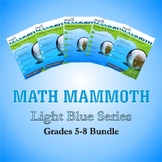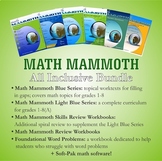Math Mammoth Grade 5 Complete Curriculum
What educators are saying
Also included in
- This bundle includes grades 5, 6, 7, and 8 from the Math Mammoth curriculum.Each grade level consists of two student worktexts (A and B; written directly to the student), answer keys, chapter tests, end-of-year test, additional cumulative reviews, and a versatile worksheet maker (Internet access reqPrice $112.50Original Price $167.00Save $54.50
- This BUNDLE OF BUNDLES contains these Math Mammoth products:Math Mammoth Blue series Math Mammoth Light Blue series Math Mammoth Skills Review workbooksMath Mammoth Review workbooks Math Mammoth Foundational Word Problems workbookPrice $280.00Original Price $592.45Save $312.45
Description
Math Mammoth Grade 5 Complete Curriculum is a complete math program for fifth grade, providing you with everything you need to teach fifth grade math. At the heart of the curriculum are two student worktexts with lessons (A and B), each covering about half a year of math work. These worktexts contain all the instruction and the exercises in the same book — which makes lesson preparation a breeze. The worktexts are written directly to the student, and thus they allow many students to teach themselves and to learn directly from the books.
You will also get separate answer keys, chapter tests, additional cumulative reviews, and a versatile worksheet maker (Internet access required) for those times when the students need just a bit more practice.
Math Mammoth focuses on conceptual understanding. It explains the "WHY", so the children can understand the math, not just learn "HOW" to do it. Concepts are often explained with visual models, followed by exercises using those models. These visual models can take the place of manipulatives for many children; however, it is very easy to add corresponding manipulatives to the lessons if so desired.
The curriculum is mastery-oriented. This means it concentrates a long time on a topic, delving into its various aspects. This promotes conceptual understanding, as opposed to spiral curricula that often tend to jump from topic to topic. There is a strong emphasis on mental math and number sense.
Very little teacher preparation is required. The curriculum has no separate teacher's manual, nor is it scripted. The introduction to each chapter has some notes for the teacher concerning the material in the chapter. All the instruction is written directly to the student in the worktext, and there are also accompanying videos where you can see Maria teaching the material.
After each chapter introduction, you will find a list of Internet links and resources (games, quizzes, animations, etc.) that can be used for fun, illustrations, and further practice.
BONUS! You will also get Soft-Pak programs completely FREE. The 6 programs in Soft-Pak (4 math, 1 language arts, 1 list maker) offer both on-screen and printable activities in a low-graphic, high content format.
The fifth grade is time for fractions and decimals, in particular. We study fractions and decimals and operations with them in depth and with substantial detail. Students also deepen their understanding of whole numbers, learn much more problem solving, and get introduced to the calculator.
The year starts out with a study of whole numbers and their operations. Students get to review multi-digit multiplication and learn long division with two-digit divisors. We also review divisibility and factors from fourth grade, and study prime factorization.
In the second chapter, the focus is on large numbers and using a calculator. This is the first time a calculator is introduced in Math Mammoth complete curriculum—thus far, all calculations have been done mentally, or with paper and pencil. I want students to learn to be critical in their use of the calculator and use it with good judgment. Every exercise where calculator use is to be allowed is marked with a little calculator symbol.
The third chapter is about equations and problem solving. We study simple equations with the help of a balance and bar models. Students also do a fair amount of problem solving using the visual bar model.
The fourth chapter is about decimals and some of the operations with decimals (the rest will be studied in chapter 6). Fifth grade is the time when students learn all the basic operations with decimals. In this chapter, we focus on place value with decimals, addition and subtraction of decimals, and multiplication and division of decimals by whole numbers. Multiplying decimals by decimals and dividing decimals by decimals is covered in chapter 6.
In chapter 5, students graph points and patterns in the coordinate grid, and learn about line graphs and average (mean). These topics tie in both with graphing in the context of algebra, and with statistical graphs.
Chapter 6 continues our study of decimals. The focus is on multiplying decimals by decimals, dividing decimals by decimals, and conversions between measuring units.
Chapter 7 covers the addition and subtraction of fractions — another focus topic of 5th grade besides decimals. The most difficult topic of this chapter is adding and subtracting unlike fractions, which is done by first converting them to equivalent fractions with a common denominator.
In chapter 8, we study the multiplication and division of fractions from various angles.
Chapter 9 takes us to geometry, starting with a review of angles and polygons. Then, students learn to classify triangles and quadrilaterals, and study the concept of volume in the context of right rectangular prisms (boxes).
Please also see the sample preview for the table of contents for 5-A and 5-B.
This is the 2023 edition of the curriculum.
The PDF files in this product can be filled in using a computer or a tablet (distance learning).
The student will need to use either Adobe Reader (on desktop/laptop) or a PDF app that has annotation tools (phones or tablets). Several PDF apps with annotation capabilities exist; see more details here.
It is recommended that you not share the entire student worktext PDF files with students. Instead, it is better to just give the students a few pages at a time. Here is a simple method for extracting a few pages from a PDF file. It is done using Google Chrome.
1. Open the PDF file in Chrome.
2. Go to "Print" (Ctrl+P).
3. Print to PDF, and choose the page range.
4. Click the "Save" button.







